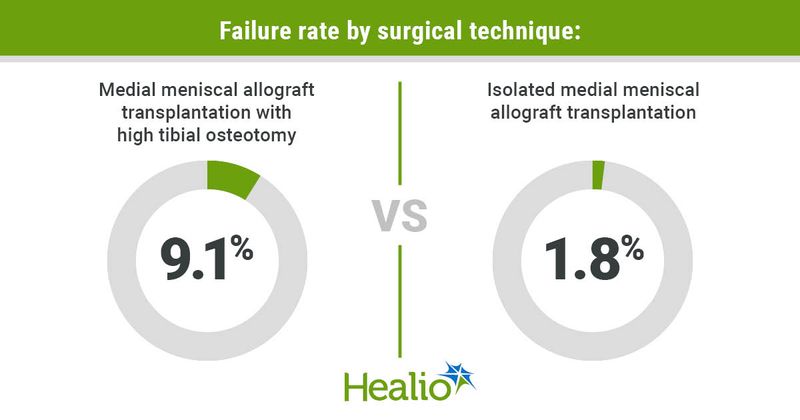Meniscal allograft transplantation with vs. without osteotomy show similar 5-year results
Key takeaways:
- Medial meniscal allograft transplantation with vs. without high tibial osteotomy had similar clinical results at 5 years.
- Combined procedures had higher surgical failure vs. isolated procedures.
Published results showed medial meniscal allograft transplantation combined with high tibial osteotomy had similar clinical results to isolated medial meniscal allograft transplantation at midterm follow-up.
“A 5-year survival rate [greater than] 90%, the good clinical results and the high patient satisfaction reported in the present study support medial [meniscal allograft transplantation] MAT plus [high tibial osteotomy] HTO as a safe and effective procedure for treating symptomatic meniscal deficit and varus malalignment,” the researchers wrote in the study. “However, those patients should be informed about the potentially slightly higher failure rate compared with patients who require an isolated medial MAT.”

In a case-control cohort study, researchers matched 55 patients who underwent medial meniscal allograft transplantation combined with HTO to 55 control patients who underwent isolated medial meniscal allograft transplantation. Outcomes included survival rates, subjective clinical scores, surgical failure, clinical failure and reoperation rates.
Researchers found all clinical outcomes improved from preoperative measures to final follow-up, with no significant differences between the two groups. In addition, researchers found the combined procedure group had a survivorship of greater than 90% at 5 years postoperatively.
However, the combined procedure group was also associated with a significantly higher surgical failure rate vs. the isolated medial meniscal allograft transplantation group (9.1% vs. 1.8%, respectively).
“Given the lack of radiological images at the final follow-up, it is necessary to further investigate with new studies,” the researchers wrote in the study. “Despite these limitations, the present study results help sports medicine surgeons to further understand the outcomes of osteotomy in complex clinical scenarios and further confirm its role with MAT as a powerful tool in joint preservation surgery.”

